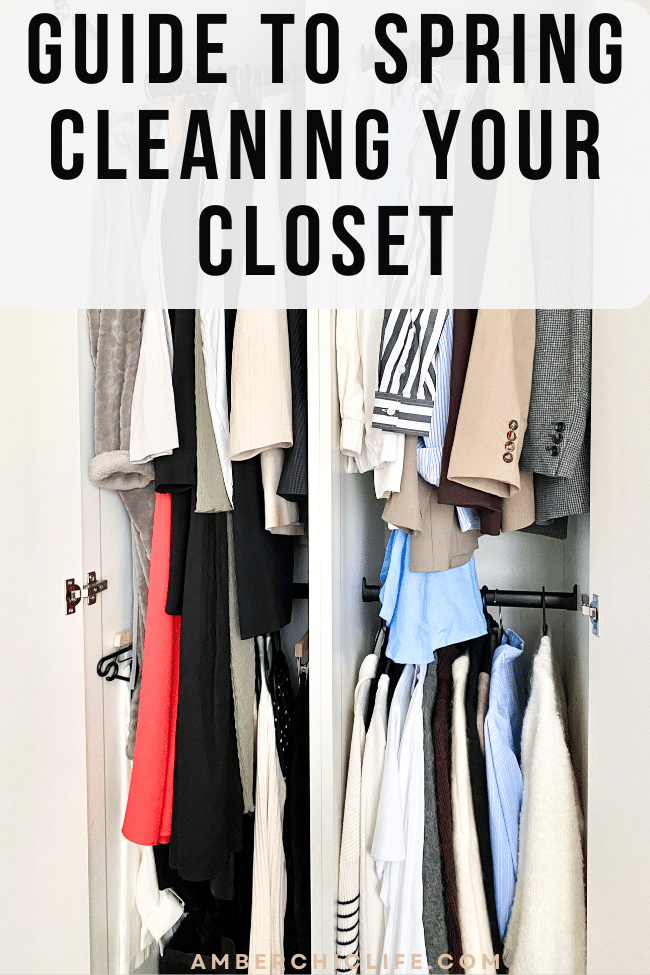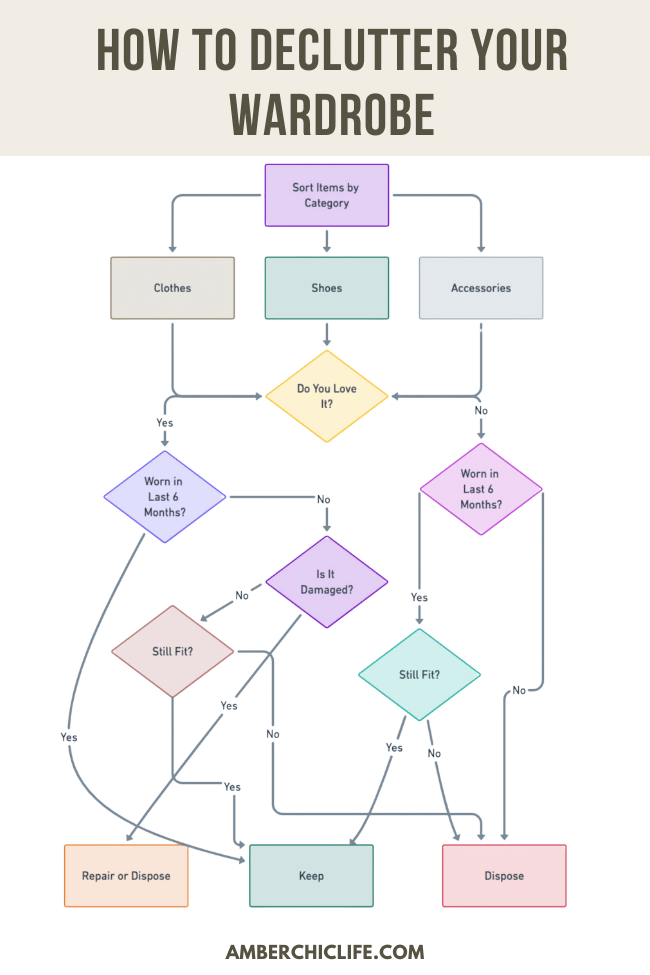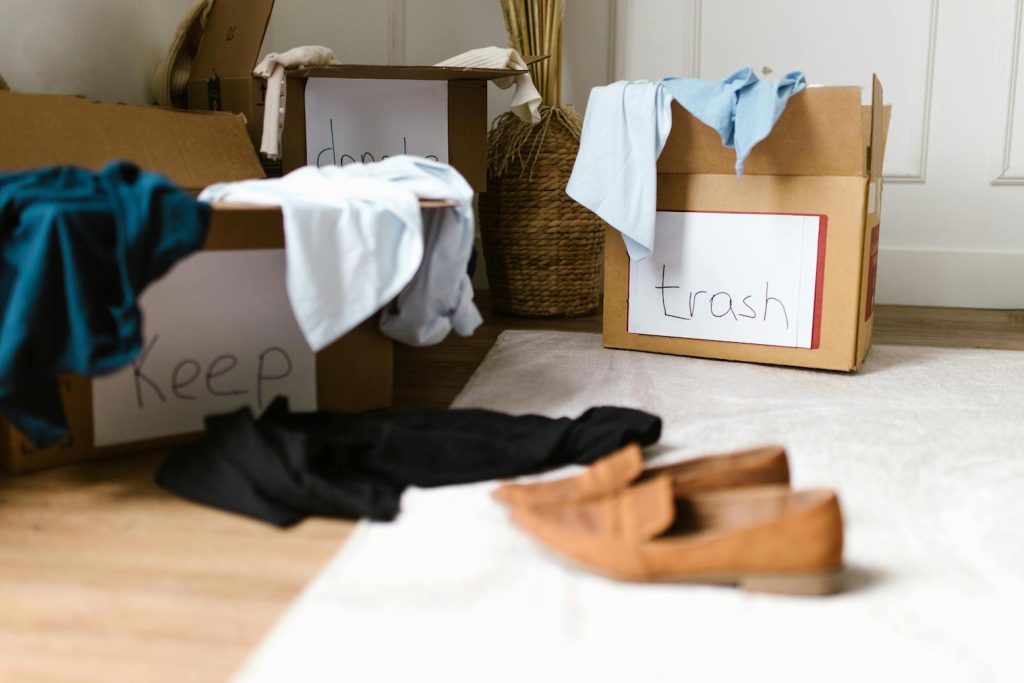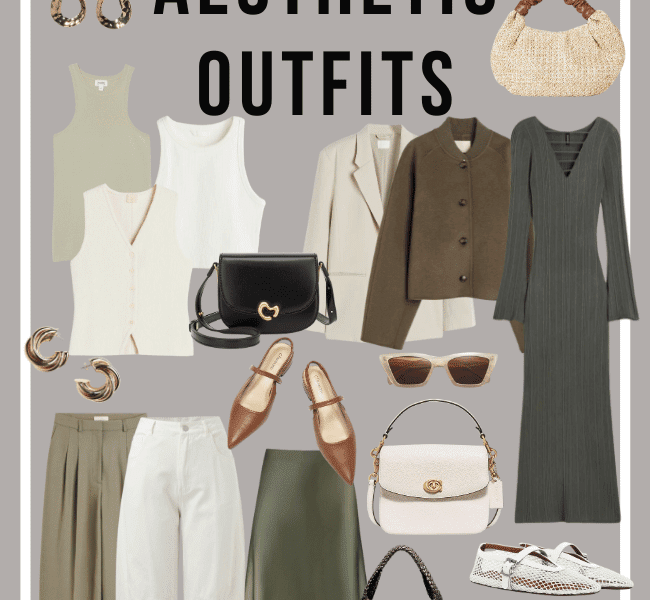This site contains affiliate links. I may earn a small commission, at no extra cost to you.
This blog post is all about spring cleaning your closet.

As the flowers bloom and the temperatures rise, spring cleaning emerges as a pivotal task on our to-do list. Among the various spaces in our homes that beg for decluttering, the closet stands out as a domain of both chaos and potential. Cleaning out your closet not only refreshes your wardrobe but also revitalizes your daily routine. Here’s a complete guide to making your spring closet cleaning not just effective but also enjoyable.
How Often Should You Clean Out Your Closet?
Cleaning out your closet regularly can help maintain an organized and functional wardrobe. Ideally, you should aim to declutter your closet at least once a season or every three to six months. This frequency allows you to reassess your clothing items in alignment with changing weather conditions, ensuring that your wardrobe remains relevant and manageable. Additionally, a seasonal review helps you identify and remove items that no longer fit, are out of style, or haven’t been worn in the past year. For those who experience significant lifestyle or body changes, more frequent closet cleanouts may be necessary to ensure the wardrobe reflects current needs and preferences.

Prepare for Spring Cleaning
Start by setting aside enough time and choosing a day free from other obligations to focus on the task. Gather necessary supplies like garbage bags for donations, storage bins for seasonal items, and cleaning materials to dust and clean the closet space. Make a checklist of areas within your closet to tackle, such as hanging items, drawers, and shelves, to ensure you cover everything. Decide on a sorting system for items to keep, donate, or discard to streamline the process. Finally, mentally prepare yourself to make tough decisions about what to part with, keeping in mind the goal of a more organized and functional wardrobe.
Sort All Your Clothes
Sorting clothes for spring cleaning can be fun and efficient with a simple plan. Start by pulling everything out of your closet to see what you have—this way, nothing gets overlooked. Make distinct piles or use separate bins for categories like “keep,” “donate,” “repair,” and “seasonal storage.”
Try on items you’re unsure about. If they don’t fit, aren’t your style anymore, or haven’t been worn in over a year (except for special occasion and sentimental value outfits ), consider passing them on. A good rule of thumb is the one-year rule. If you haven’t worn a piece of clothing in the last year (excluding special occasions), it’s likely time to let it go. Items in good shape can find new homes through donation centers or thrift stores. Finally, organize your “keep” pile back into your closet, grouping items in a way that makes sense for your daily life, like by color, occasion, or season, to make finding what you need a breeze.

Put Seasonal Items in Storage
Storing seasonal clothes efficiently can free up a lot of space and keep your wardrobe organized. First step is to clean you winter clothes before storing them to prevent any dirt or odors from setting in. Use clear, airtight storage bins to protect your items from dust, moisture, and pests—labeling each bin with its contents and the season it’s for.
Vacuum-sealed bags are great for bulky items like winter coats and sweaters, as they save space and protect fabrics. Padded hangers, coat hangers and garment bags are great option for your heavy wool coats and leather jackets. These items can easily lose their shape if not stored correctly. Finally, choose a cool, dry place for storage, like under the bed or on a high closet shelf, to keep your items in good condition until the season changes again.
Organize Your Closet
Now this is a fun part: making everything find right place.
Categorize
Sort your remaining items into categories such as tops, pants, dresses, outerwear, shoes and accessories. This categorization makes it easier to find what you’re looking for and helps identify duplicates or gaps in your wardrobe.
Prioritize Placement
Decide which clothes should be hung and which folded. Store frequently used items at eye level or within easy reach, and less frequently used items higher up or towards the back. Seasonal items can be rotated in and out of more accessible places as needed.
Use Organizers
For effective closet organization, consider incorporating a variety of organizers tailored to different types of items in your wardrobe. Here are some useful organizers:
- Hanging Organizers: Ideal for maximizing vertical space, these can be used for clothes that should be hung, like dresses, shirts, and jackets, or for compartmentalizing accessories, scarves, and belts.
- Shelf Dividers: These help keep folded items such as sweaters and jeans neatly separated on open shelves, preventing stacks from toppling over.
- Drawer Organizers: Perfect for sorting smaller items like socks, underwear, and accessories into compartments for easy access and visibility.
- Clear Shoe Boxes or Over-the-Door Shoe Organizers: Keep your shoes orderly and off the floor. Choose a style that fits your space and the number of shoes you own.
- Storage Boxes/Bins: Great for seasonal items, these can be labeled and stored on higher shelves or under the bed. Opt for clear bins to easily see the contents.
- Velvet Hangers: Uniform hangers not only give your closet a cohesive look but also save space. Velvet hangers prevent clothes from slipping off.
- Hanging Hooks: Use hooks on the back of the closet door or on unused wall space for hanging hats, bags, and jewelry.
- Undergarment Organizers: Specialized organizers for bras and underwear can fit inside drawers, keeping these items in good shape and easy to find.

Fill in the Gaps
After purging, you might notice gaps in your wardrobe. Make a list of essentials missing from your collection—be it the perfect pair of jeans or basic tops in neutral colors. This focused approach prevents impulse buys and ensures your new purchases truly add value to your wardrobe. I strongly suggest to invest in building capsule wardrobe, that all items are easily mixed and matched. But don’t forget incorporating few trendy pieces for new season.
Read more:
How to Build Capsule Wardrobe in 2024
20 Piece Timeless Spring Capsule Wardrobe
Earthy Aesthetic Outfits Ideas for Spring
Top Tips for Keeping Your Closet Organized
To ensure your closet remains a haven of order and style, stick to a few key habits:
- Review Regularly: Make it a habit to review your closet every season. This can prevent the accumulation of unwanted items and keep your wardrobe aligned with your current personal style.
- One-In, One-Out Rule: For every new item introduced into your closet, remove an old one. This maintains balance and prevents clutter.
- Donate Regularly: Keep a donation bin within easy reach to simplify the process of parting with items you no longer need or want.
- Invest in Quality Over Quantity: Instead of chasing the latest trend, invest in high-quality pieces that endure both in style and durability. This approach saves money and closet space in the long run.
Spring cleaning your closet is more than just a chore; it’s an opportunity for a fresh start. By following these basic steps, you can transform an untidy closet into an organized, functional, and joyful part of your daily life. Welcome the new season with not just a clean closet but also a lighter, more intentional approach to your wardrobe.
You may also like:


